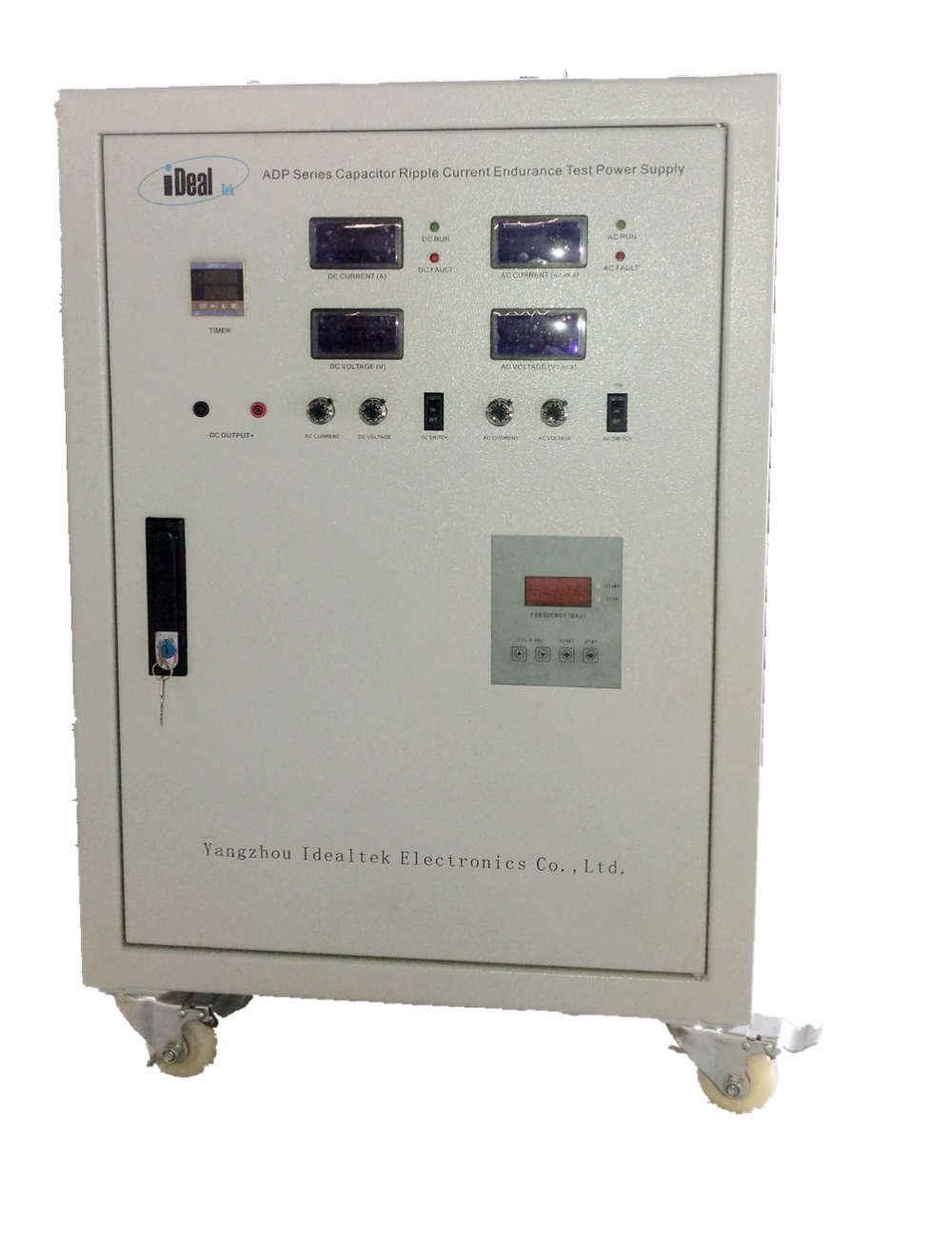Capacitor Leakage Test Power Supplies The ADP series capacitor leakage test power supply is specially designed and customized for capacitor manufacturers` product quality control process or users of capacitors for capacitor ripple current durability life test.
Capacitor Leakage Current Power Supplies, Leakage Current Ripple Power Supplies, AC and DC Power Supplies, Capacitor Test Power Supplies, Ripple Current Test Power Supplies Yangzhou IdealTek Electronics Co., Ltd. , https://www.idealtekpower.com

Capacitor leakage current test power supply is aimed at the diversity of output voltage and frequency required for different capacitance tests with the DC output voltage up to 3000Vdc, the AC voltage output up to 200Vac, the AC current up to 500A, and the output frequency can be selected according to customer requirements from 50Hz to 100KHz.
Equipped with special high-frequency and high-temperature fixtures and connecting wires for capacitor leakage current testing, the capacitor leakage current test power supply can imitate the actual working conditions of capacitors to determine the service life of a group of capacitors under test, providing the accurate parameters of capacitors required by the manufacturer for the capacitors R&D and quality inspection test, the power supply is now aiding the test of high-frequency and high-current passive devices such as high-frequency capacitors, film capacitors, electrolytic capacitors, ballast capacitors, and ballast inductors.
"Who said that charging has to be connected with a wire? Just let your phone and charger 'sense each other'—and you can charge! Let’s dive into the principle of 'wireless charging'!
Every time you want to power up your phone, laptop, or other electronic devices, you always have to grab a charging cable. With so many cables around, it's easy to get confused and end up with the wrong one. It's really inconvenient. Fortunately, more and more devices are now adopting 'wireless charging' technology. All you need to do is place your phone on a small, cup-shaped pad, and you can charge it without any wires. But how does this amazing technology actually work? Let’s explore it together.
[Image: Wireless charging pad]
**Electrical and Magnetic Interaction**
The most common form of wireless charging relies on the "current magnetic effect" and "electromagnetic induction." In 1819, Danish scientist Hans Christian Ørsted discovered that when current flows through a wire, a magnetic field is created around it, which can affect a compass needle. Later, scientists found that if the wire is shaped into a loop or coil, the magnetic field becomes stronger and more concentrated. This is known as the "current magnetic effect."
Then there's electromagnetic induction, discovered by Michael Faraday in 1831. He found that when a magnet or a changing magnetic field is placed near a coil with no current, it induces a current in the coil. This phenomenon is called "electromagnetic induction." Importantly, for this to happen, the magnetic field must be changing—like when a magnet moves closer or farther away. If the magnetic field remains constant, no current is induced.
In short, the current magnetic effect means that electricity creates a magnetic field, while electromagnetic induction occurs when a changing magnetic field causes current to flow in a coil.
[Image: Electromagnetic induction diagram]
**Using Electromagnetic Induction for Charging**
These two physical principles are used together in wireless charging. A typical wireless charging device includes a "charging pad," which is essentially a coil. When the pad is plugged into an outlet, current flows through the coil, creating a magnetic field due to the current magnetic effect. The device being charged also contains a coil. When it's placed near the charging pad, the changing magnetic field from the pad induces a current in the device’s coil via electromagnetic induction. This current is then directed to the battery, completing the wireless charge.
You might wonder—doesn't electromagnetic induction require a changing magnetic field? But the distance between the pad and the device stays the same. The answer lies in the fact that the electricity coming from the wall is alternating current (AC), meaning it constantly changes direction. As a result, the magnetic field produced by the coil also changes, satisfying the conditions for electromagnetic induction.
Recently, more smartphones and tablets have started to support wireless charging. However, even with the latest technology, the charging efficiency drops significantly if the device is not placed directly on the pad. Most devices still need to be flat on the charging surface, and the convenience of wireless charging is still limited compared to wired options.
[Image: Resonance charging setup]
**Using Resonance to Increase Charging Distance**
To improve both the distance and efficiency of wireless charging, scientists are exploring the use of "magnetic resonance." By adding components like capacitors and inductors to the circuit, a "resonant circuit" can be formed. Think of it like a tuning fork: when struck, it vibrates at its natural frequency and continues to do so for a while. Similarly, a resonant circuit, once energized, can generate a signal that lasts for some time.
Tuning forks have a special property called "resonance." Each has a specific frequency. If another fork with the same frequency is nearby, it will vibrate too, even without being touched. This resonance allows energy to be transferred. The same principle applies to resonant circuits. When two circuits with the same frequency are placed close to each other, one can induce a current in the other, allowing energy to be transmitted through space. This is called "magnetic resonance" and is used in advanced wireless charging systems. It can allow charging over several meters with better efficiency. The challenge is keeping both circuits tuned to the same frequency consistently.
In addition to magnetic resonance, some researchers are experimenting with using laser light or radio waves, similar to Wi-Fi, to transmit energy. With further breakthroughs in these technologies, we may soon enjoy even more convenient and flexible charging solutions in the future!"
(Word count: 576)
August 02, 2025